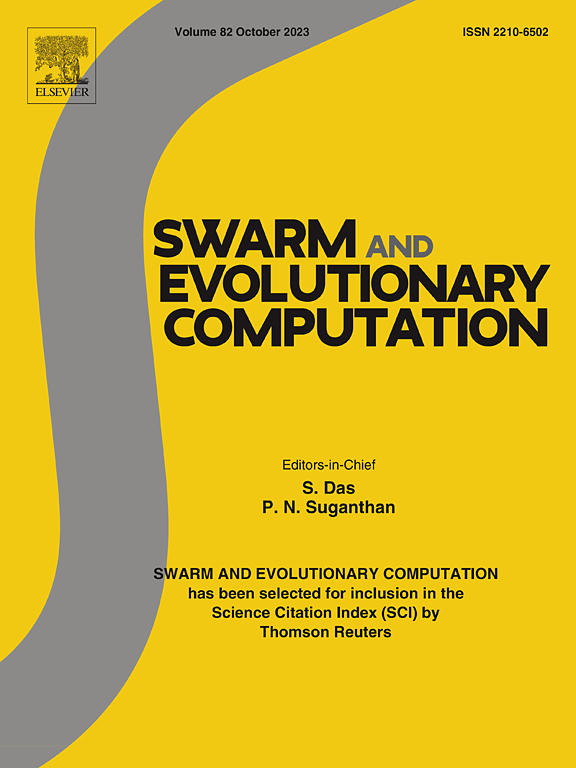Hierarchical heterogeneous ant colony optimization based weight generation for texture classification
IF 8.5
1区 计算机科学
Q1 COMPUTER SCIENCE, ARTIFICIAL INTELLIGENCE
引用次数: 0
Abstract
Texture classification is an important problem in pattern recognition and computer vision. The goal of texture analysis is to represent texture in a model that is invariant to changes influenced by illumination, rotation and noise. Natural images exhibit structures that are highly complex and therefore texture analysis have turned a challenging problem. Moreover, textures in real-time environment contain textural information at varying scales. Local Binary Pattern (LBP) is an effective non-parametric texture operator that encodes the local structure around each pixel. This paper proposes a Similarity based Texture Classification for LBP (STC-LBP) algorithm for classification of texture images. STC-LBP algorithm classifies the query texture image based on the similarity of LBP features. To find an optimal weight that emphasizes the similarity between features, a Hierarchical Heterogeneous Ant Colony Optimization based Weight Generation (HHACOWG) algorithm is proposed. Experiments were performed on five benchmark texture datasets namely KTH-TIPS, Brodatz, CUReT, Outex_TC10 and Outex_TC12 datasets. Experiments reveal that the proposal achieves better classification accuracy when compared to the state-of-art methods. The scale and rotation invariance property of STC-LBP is significantly better compared to the existing texture descriptors. The proposal is also tolerant to noise and illumination changes. The results of experiments were validated using non-parametric statistical tests. The feature dimension of the proposal is significantly less compared to the existing descriptors for texture classification. The time taken for feature extraction is less compared to the existing methods indicating that the proposal is well suited for real-time applications.
基于层次异构蚁群优化的纹理分类权值生成
纹理分类是模式识别和计算机视觉中的一个重要问题。纹理分析的目标是用不受光照、旋转和噪声影响的模型来表示纹理。自然图像呈现出高度复杂的结构,因此纹理分析已经成为一个具有挑战性的问题。此外,实时环境中的纹理包含了不同尺度的纹理信息。局部二值模式(LBP)是一种有效的非参数纹理算子,它对每个像素周围的局部结构进行编码。本文提出了一种基于相似性的纹理分类算法(STC-LBP),用于纹理图像的分类。STC-LBP算法基于LBP特征的相似性对查询纹理图像进行分类。为了寻找强调特征间相似性的最优权值,提出了一种基于分层异构蚁群优化的权值生成算法。在KTH-TIPS、Brodatz、CUReT、Outex_TC10和Outex_TC12 5个基准纹理数据集上进行实验。实验表明,与现有的分类方法相比,该方法具有更好的分类精度。与现有纹理描述符相比,STC-LBP的尺度和旋转不变性明显更好。该方案还能适应噪音和照明的变化。实验结果采用非参数统计检验进行验证。与现有的纹理分类描述符相比,该方法的特征维数明显减少。与现有方法相比,特征提取所需的时间更短,表明该建议非常适合实时应用。
本文章由计算机程序翻译,如有差异,请以英文原文为准。
求助全文
约1分钟内获得全文
求助全文
来源期刊

Swarm and Evolutionary Computation
COMPUTER SCIENCE, ARTIFICIAL INTELLIGENCEC-COMPUTER SCIENCE, THEORY & METHODS
CiteScore
16.00
自引率
12.00%
发文量
169
期刊介绍:
Swarm and Evolutionary Computation is a pioneering peer-reviewed journal focused on the latest research and advancements in nature-inspired intelligent computation using swarm and evolutionary algorithms. It covers theoretical, experimental, and practical aspects of these paradigms and their hybrids, promoting interdisciplinary research. The journal prioritizes the publication of high-quality, original articles that push the boundaries of evolutionary computation and swarm intelligence. Additionally, it welcomes survey papers on current topics and novel applications. Topics of interest include but are not limited to: Genetic Algorithms, and Genetic Programming, Evolution Strategies, and Evolutionary Programming, Differential Evolution, Artificial Immune Systems, Particle Swarms, Ant Colony, Bacterial Foraging, Artificial Bees, Fireflies Algorithm, Harmony Search, Artificial Life, Digital Organisms, Estimation of Distribution Algorithms, Stochastic Diffusion Search, Quantum Computing, Nano Computing, Membrane Computing, Human-centric Computing, Hybridization of Algorithms, Memetic Computing, Autonomic Computing, Self-organizing systems, Combinatorial, Discrete, Binary, Constrained, Multi-objective, Multi-modal, Dynamic, and Large-scale Optimization.
 求助内容:
求助内容: 应助结果提醒方式:
应助结果提醒方式:


